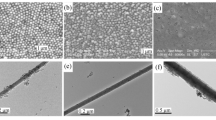Abstract
Nanoporous Anodic Aluminum Oxide (AAO), its average diameters of porous were 50 nm, was obtained by two-step electrochemical anodization aluminum process. Highly ordered luminescence arrays formed by filling AAO nanopores with quercetin molecules has been studied by fluorescent spectroscopy in this work. AAO showed stronger adsorption capability of quercetin than Al3+-quercetin complex. The mechanism may be physical and chemical adsorption all together. Meanwhile, red shift of the maximum fluorescence peak of quercetin in AAO was observed. The molecular assemblies in the nanopore array are highly ordered and the fluorescence polarization dependence indicates a preferred molecular orientation along the pore axis. This maybe explains the mechanism of molecular luminescence depending on its environment.
Similar content being viewed by others
REFERENCES
A. P. Li, F. Mueller, A. Birner, K. Nielsch, and U. G¨osele (1998). Hexagonal pore arrays with a 50-420 nm interpore distance formed by self-organization in anodic alumina. J. Appl Phys. 84(11), 6023-6026.
G. L. Hornyak, C. J. Patrissi, and C. R. Martin (1997). Fabrication, characterization, and optical properties of gold nanoparticle/porous alumina composites: The nonscattering Maxwell-garnett limit. J. Phys. Chem B. 101(10), 1548-1555.
R. Reisfeld (2002). Fluorescent dyes in sol-gel glasses. J. Fluorescence. 12(3/4), 317-326.
J. Karolin, C. D. Geddes, K. Wynne, and D. J. S. Birch (2002). Nanoparticle metrology in sol-gels using multiphoton excited fluorescence anisotropy decay. Meas. Sci. Technol. 13(1), 21-27.
I. A. Levitsky, J. Liang and J. M. Xu (2002). Highly ordered arrays of organic-inorganic nanophotonic composites. Appl. Phys. Lett. 81(9), 1696-1698.
H. Masuda, H. Asoh, M. Watanabe, K. Nishio, M. Nakao, and T. Tamamura (2001). Square and triangular nanohole array architectures in anodic alumina. Adv. Mater. 13(3), 189-192.
Y. Yamamoto, N. Baba, and S. Tjima (1981). Coloured materials and photoluminescence centers in anodic film on alumina. Nature 289(12), 572-574.
R. A. Hahn and D. Bloor (1991). Organic Materials for Nonlinear Optics, Royal Society of Chemistry, Cambridge.
M. Bruchez, M. Moronne, P. Gin, S. Weiss, and A. P. Alivisatos (1998). Semiconductor nanocrystals as fluorescent biological labels. Science 281, 2013-2016.
W. C. Chan and S. M. Nie (1998). Quantum dot bioconjugates for ultrasensitive nonisotopic detection. Science 281, 2016-2018.
Y. Yang, H. Y. Li, H. L. Chen, and X. M. Bao (2002). Luminescence study of fluorescent dye impregnated into Si-based nanoporous alumina. Chem. J. Chin. Univ. 23(5), 768-771.
C. X. Xun, Q. H. Xue, L. Ba, B. Zhao, N. Gu, Y. P. Cui (2001). Photoluminescence of 8-hydroxyl quinoline-Al 3 C complex on nanopores anodic aluminum oxide. J. Chin. Sci. Bull. 46(12), 984-987.
H. Masuda and Fukuda K.(1995). Ordered metal nanohole arrays made by a two-step replication of honeycomb structures of anodic alumina. Science 268, 1466-1468.
P. Braunstein, H. P. Kormann, W. Meyer-Zaika, R. Pugin, and G. Schmid (2000). Strategies for the anchoring of metal complexes, clusters, and colloids inside nanoporous alumina membranes. Chem. Eur. J. 24(6), 4637-4646.
G. Schmid, M. Baumle, M. Geerkens, I. Heim, C. Osemann, and T. Sawitowski (1999). Current and future applications of nanoclusters. Chem. Soc. Rev. 28(1), 179-185.
G. Z. Chen, X. Z. Huang, and J. G. Xu. (1999). Methods of Fluorescence Analysis, 2nd ed., Science Press, Beijing, pp. 3-14.
M. Kasha, H. R. Rawls, and M. Ashraf El-Bayoumi (1965). The exciton model in molecular spectroscopy. Pure Appl. Chem. 11(5), 371-392.
Author information
Authors and Affiliations
Corresponding author
Rights and permissions
About this article
Cite this article
Chang, X., Wang, S., Luo, H. et al. Study on Fluorescence Characteristic of Quercetin–Nanoporous Anodic Aluminum Oxide Composites. Journal of Fluorescence 13, 421–425 (2003). https://doi.org/10.1023/A:1026117006830
Issue Date:
DOI: https://doi.org/10.1023/A:1026117006830




